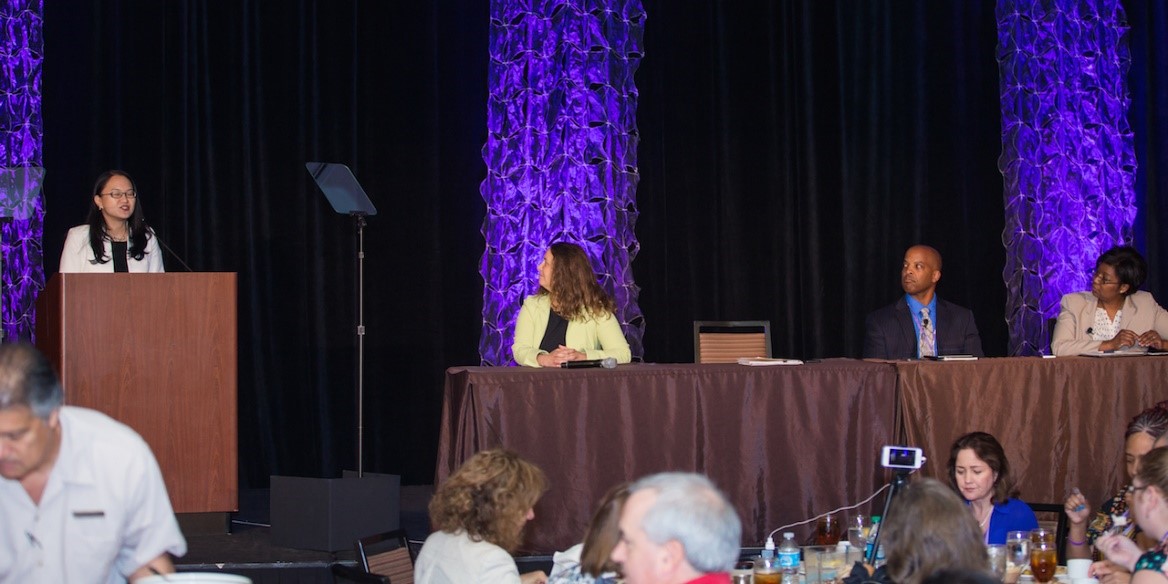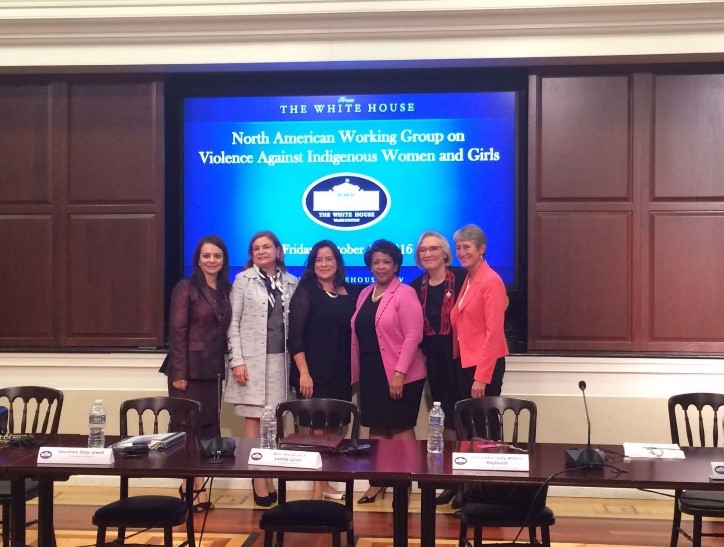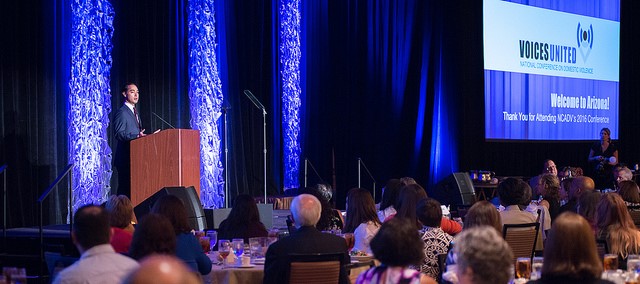
When President Obama declared October 2016 as Domestic Violence Awareness Month, he coupled his yearly proclamation with a challenge to “recommit to doing everything in our power to uphold the basic human right to be free from violence and abuse.” While rates of domestic violence against women have dropped by nearly three-quarters in the past two decades, still approximately 1 in 4 women and 1 in 7 men have suffered from severe domestic violence by an intimate partner. To raise awareness and improve our nation’s response to survivors, the White House, along with federal agency partners and advocates, took part in numerous events this month to recognize Domestic Violence Awareness Month.
Among many activities, the Vice President hosted a reception in his home in honor of the 22nd anniversary of the Violence Against Women Act and the second anniversary of the It’s On Us campaign. At the reception, he thanked all of the students, advocates, and federal employees who have worked tirelessly to end to our national culture of violence against women and girls. Additionally, the White House convened the first-ever tri-lateral working group to address violence against indigenous women and girls; federal agencies have made unprecedented steps to ensure that victims and survivors of domestic violence, including those in the LGBT community, have inclusive and accessible fair housing and health protections that are codified into law; and federal representatives participated in several events convened by the advocacy community to celebrate successes and lay the groundwork for the future undertakings.
During this time, it is important to pay tribute to the courageous survivors and outstanding individuals who work so hard to ensure that victim services are available and that both offenders and institutions that condone violence are held accountable. The Office of the Vice President is proud to share highlights from this month’s activities.
The White House Participates in Nationwide Conferences Addressing Domestic Violence
National Coalition Against Domestic Violence (NCADV) National Conference: Voices United
On October 23-26, in Chandler, AZ, the National Coalition Against Domestic Violence hosted its national conference, Voices United, that brought together more than 400 survivors, victim advocates, and intimate partner violence experts to discuss such topics as the intersection of guns and domestic violence, trauma-informed approaches to addressing domestic violence, traumatic brain injury, housing stability and domestic violence, and culture change. I was honored to join Department of Housing and Urban Development (HUD) Secretary Julian Castro, who announced HUD’s new rules that will expand protections for victims and survivors of domestic violence (see below). I discussed the White House’s inaugural convening of the North American Working Group on Violence Against Indigenous Women and Girls (see next section) and shared other new agency initiatives (also below). The conference also included plenary panels and individual sessions that covered a range of topics including: rapid rehousing, sex trafficking, firearms and domestic violence, engaging men sustainably and accountably, and domestic violence against women with disabilities.

DOJ Office on Violence Against Women’s (OVW) Legal Assistance for Victims Grantee Conference
On October 24-25, in Washington, DC, Kris Rose, Senior Policy Advisor in the Office of the Vice President (OVP), gave remarks at a conference for grantees of the Legal Assistance for Victims (LAV) Grant Program, administered by DOJ's Office on Violence Against Women. The first-of-its-kind meeting brought together attorneys, advocates, and others who provide legal assistance to victims of domestic violence, sexual assault, dating violence, and stalking. Victims of these crimes have a broad range of legal needs, ranging from child custody and divorce, civil orders of protection, immigration, nuisance abatement and employment issues. Bea Hanson, the Department of Justice’s OVW Principal Deputy Director kicked off the meeting, followed by a presentation by Rob Valente from the National Domestic Violence Hotline on the history of the LAV program under the Violence Against Women Act. The two-day agenda was packed with plenary panels and workshops covering such topics as addressing sexual assault on college campuses, advocating for tribal clients, implementing language access programs, and improving legal access for LGBT survivors of intimate partner and sexual violence.
Inaugural Convening of the North American Working Group on Violence Against Indigenous Women and Girls
While the end of October marks the close of Domestic Violence Awareness Month, we recognize the start of Native American Heritage Month in November. Throughout the Administration, President Obama and Vice President Biden have made historic strides to advance Tribal sovereignty, and strengthen justice system responses to violence against Alaska Native and American Indian women and girls. In 2013, the reauthorization of the Violence Against Women Act (VAWA) recognized Tribes’ inherent authority to prosecute certain defendants who commit acts of domestic violence in Indian Country—whether they are Native American or not—a critical step in increasing justice for Native communities. As detailed in previous blogs (see here and here and a recent report from the National Institute of Justice), 84 percent of American Indian and Alaska Native women and girls have experienced some form of violence in their lifetimes. Of those women, 56 percent experienced sexual violence and 55 percent experienced physical violence from an intimate partner—and 97 percent experienced violence by a perpetrator who was not American Indian or Alaska Native.
These high rates of violence against Indigenous women and girls also exist in Canada and Mexico, and across our shared borders. To address this continent-wide scourge, earlier this month, the White House hosted the inaugural meeting of a new North American Working Group on Violence against Indigenous Women and Girls. The meeting was led by U.S. Attorney General Loretta Lynch and Department of Interior Secretary Sally Jewell, who were joined by their counterparts from Mexico and Canada—all of whom are women. The day began with remarks from Valerie Jarrett, Senior Advisor to the President and Chair of the White House Council on Women and Girls; Catherine Russell, Ambassador-at-Large for Global Women’s Issues; and a letter I read aloud from the Vice President. Senior representatives from all three countries then engaged in working sessions on health, human rights, and criminal justice responses to domestic violence, sexual assault, and human trafficking of Indigenous women and girls. In between these working sessions, Tina Tchen, Assistant to the President and Executive Director of the White House Council on Women and Girls; Ambassador Keith Harper, U.S. Representative to the United Nations Human Rights Council; and Karen Diver, Special Assistant to the President for Native American Affairs, facilitated a group dialogue on the role of Indigenous representatives in subsequent meetings. Next year, we look forward to building on the strong foundation created by the first convening when our partners from Canada host the Working Group in 2017. For a complete overview of the inaugural meeting, including new announcements from the Administration and our trilateral partners, check out our blog from October 26.

Federal Agencies Release New Rules and Guidance to Ensure Safeguards for Survivors and Victims of Domestic Violence
New Protections on Housing Accessibility and Inclusivity
Last week, HUD finalized a new rule that enhances housing protections for survivors of domestic and dating violence, sexual assault, and stalking, and affirms their basic right to a safe place to live. Several key elements of the new rule include:
- Codifying core protections across HUD’s covered programs to ensure survivors are not denied assistance as an applicant, or evicted or have assistance terminated due to having been a victim of domestic violence, dating violence, sexual assault, and stalking.
- Adopting a model emergency transfer plan for housing providers and to explain how housing providers must address their tenants’ requests for emergency transfers.
- Ensuring that covered housing providers cannot deny tenancy or occupancy rights based solely on adverse factors, such as credit history or property damage by a perpetrator, that are a direct result of being a survivor.
- Making clear that under most circumstances, a survivor need only to self-certify in order to exercise their rights under VAWA.
As described above, Secretary Castro announced this new rule last week at the National Coalition Against Domestic Violence’s national conference, declaring “to all survivors: we stand with you.”

This rule comes on the heels of Fair Housing Act guidance that HUD issued last month to assist local governments in assessing their local nuisance and crime-free ordinances to ensure they don’t violate victims’ rights under the Fair Housing Act. These nuisance and crime-free ordinances can result in housing discrimination by requiring or encouraging evictions for use of emergency services, including 911 calls. Too often, these ordinances cause survivors of domestic violence to have to choose between keeping their home or protecting their own lives.
Long-Awaited Regulations on the Family Violence Prevention and Services Act (FVPSA)
This month, the Department of Health and Human Services issued a landmark rule clarifying the use of funds for programs under the Family Violence Prevention and Services Act (FVPSA)—the first comprehensive revision of FVPSA since 1996. It does a number of things to update the regulations, including: reinforcing grantee program accessibility requirements; reflecting the evolution in domestic violence program services such as the National Domestic Violence Hotline’s addition of digital services; explaining that FVPSA grant-funded services must be voluntarily accepted and that no conditions may be imposed on the recipient of emergency shelter; adding new discretionary grant programs resulting from FVPSA’s 2010 reauthorization, Specialized Services for Abused Parents and Their Children, and State resource centers to reduce disparities in domestic violence services for American Indian, Alaska Native, and Native Hawaiian populations.
Perhaps most critically, the new rule reinforces FVPSA anti-discrimination provisions and their applicability to all grant-funded programs, including prohibitions against discrimination based on sexual orientation and gender identity.
Enhanced Focus on Federal Workplace Accountability for Domestic and Sexual Violence
Another agency that has made historic steps to address domestic violence is the Office of Personnel Management (OPM)—the agency that effectively serves as the Human Resources director for the entire Federal family of employees. In 2012, President Obama issued a Presidential Memorandum directing OPM to establish Government-wide Guidance to Address the Effects of Domestic Violence on the Federal Workforce under the premise that, as the nation's largest employer, the Federal Government should act as a model in responding to the effects of domestic violence on its workforce. OPM has continued to work with agencies across the government to enhance departmental policies that support employees impacted by domestic violence, sexual assault, and stalking.
One concrete example of OPM’S work is a new online training, jointly developed with the Justice Department, that teaches Federal employees how to recognize, respond and refer colleagues who may be experiencing domestic violence, sexual assault, or stalking, to the correct resources. The course, which is available on to all Federal employees on www.hru.gov (Human Resources University), as well as agencies’ internal learning management systems, explains why domestic and sexual violence are workplace issues, when they impact employees, how to support victim confidentiality in the workplace; links to external resources such as 24-hour hotlines; and offers interactive scenarios to help users think about how to respond in different situations. OPM’s employees and Federal allies came together in a show of support survivors in a Domestic Violence Awareness solidarity walk around the White House and encouraged agencies to share their DV awareness efforts through the hashtag #FedsEndDV. To close the month, OPM hosted a government-wide Forum on Domestic Violence, Sexual Assault and Stalking in the Workplace to support the 40 Federal agencies that now have policies in place for employees whose lives are impacted by domestic violence. Truly, a significant cohort of our Federal family is committed, now more than ever, to building a government-wide culture that is survivor-centered and trauma-informed.
Funding Investments to Address the Intersection of Domestic Violence, the Criminal Justice System, and Policing
As I discussed in a recent blog, last December, the Department of Justice released new guidance on “Identifying and Preventing Gender Bias in Law Enforcement Response to Sexual Assault and Domestic Violence.” It is critically important to make sure we are looking at all of the places where bias may exist—on the basis of race, sex, sexual orientation, gender identity, immigration status, disability, and the frequent intersection of these complex identities.
To support communities’ efforts to put the Guidance into practice, this month, the Justice Department invested nearly $10 million dollars in several new programs, including an award of $5 million from the Office for Victims of Crime (OVC) to the International Association of the Chiefs of Police (IACP) to lead an initiative on identifying and preventing gender bias in law enforcement response to victims; awards totaling $2.85 million by the Office on Violence Against Women (OVW) to five grantees under OVW’s Improving Criminal Justice Responses to Sexual Assault, Domestic Violence, Dating Violence, and Stalking Grant Program, to integrate the principles outlined in the DOJ guidance into law enforcement policies, training, supervision protocols, and systems of accountability; three awards, totaling $1.65 million by OVW for national technical assistance to be provided by IACP, the Police Executive Research Forum (PERF) and End Violence Against Women International (EVAW) to develop resources, provide trainings, and help build the capacity of police departments; and a $400,000 research award by OVW to evaluate the effectiveness of training based on the guidance for sworn officers in an urban police department.
In a similar vein, OVW announced their new website, "Safe Families, Safe Communities,” for the purposes of enforcing domestic violence firearm prohibitions. The website is a project of the newly-established resource center, designed to support the implementation and enforcement of domestic violence firearm prohibitions to reduce firearm-involved domestic violence and homicide.
We’re Not Finished: Be Bold
We are so proud of the invaluable work this Administration has done, but also grateful to be partners with such a committed advocate community. But, what’s next? With less than 100 days until the end of the Administration, we are taking stock of the unfinished work, and while we may only have a few months left, we are not going to slow down. I recently attended a meeting with Vice President Biden and his senior staff where he reflected on the work of the Administration over the past eight years and his message was very clear: Although we have made extraordinary gains, we still have a lot of work left to do. During our last few months, we’re going to run—sprint, actually—to the finish line. The Vice President encouraged us to be bold. Bold with our ideas, bold with our convictions, and bold with our intentions.
I share that message with all of you—be bold and continue this good work into the future.
Members of the Violence Against Women team in the White House Office of the Vice President—Kris Rose, Senior Policy Advisor; Cailin Crockett, Policy Advisor; Jaimie Woo, Policy Analyst—and Jordan Brooks, Deputy Executive Director of the Council on Women and Girls, all contributed to this blog.


